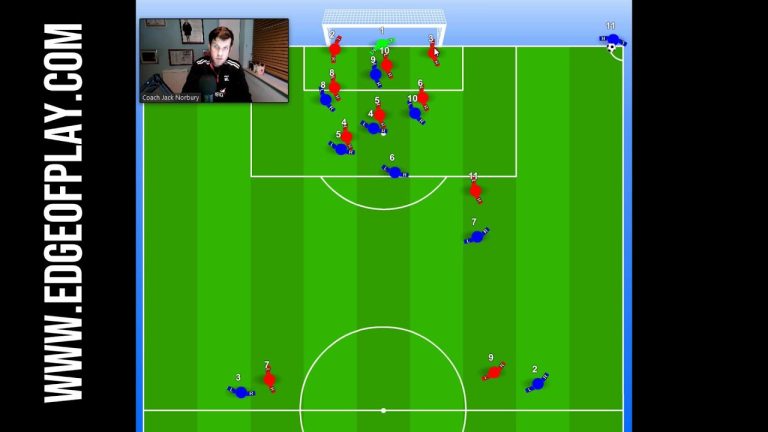As a goalkeeper, one of the key strategies to master is analyzing the opponent’s shooting patterns. By closely observing their every move, from their body positioning to their preferred target areas, goalkeepers can gain a crucial advantage in stopping their shots. In this article, we delve into the art of studying and understanding the opponent’s shooting patterns, equipping goalkeepers with the knowledge and skills to make those game-changing saves. Join us as we explore the intricacies of this vital aspect of the goalkeeper’s game.
How can the performance of a goalkeeper be analyzed?
Analyzing a goalkeeper involves considering various factors related to their tactical and technical actions in both offensive and defensive situations. In offensive scenarios, the type of pass and passing zone are crucial variables to assess. Understanding the goalkeeper’s ability to distribute the ball accurately and effectively is essential in evaluating their overall performance.
On the defensive side, it is important to examine goals and shots conceded as well as the types of saves made by the goalkeeper. This provides insights into their shot-stopping capabilities and their ability to prevent goals. Additionally, assessing the basic actions of a goalkeeper, such as positioning and decision-making, helps in understanding their overall effectiveness in protecting the goal.
By considering these variables, a comprehensive analysis of a goalkeeper’s performance can be achieved. Evaluating both their offensive and defensive actions enables a deeper understanding of their skills and effectiveness in different game situations.
Why does a goalkeeper retract his hands?
A goalkeeper pulls his hands backwards to maximize his ability to hold onto the ball. By pulling his hands backwards, he effectively increases the amount of time he has to secure the ball in his grasp. This extra time allows him to firmly grip the ball and prevent it from slipping away.
In addition to providing a better grip, pulling the hands backwards also reduces the force applied by the football on the goalkeeper. When the ball comes into contact with the goalkeeper’s hands, it exerts a certain amount of force. By extending the contact time through pulling the hands backwards, the rate of change of momentum decreases, resulting in less force being exerted on the goalkeeper.
Overall, the goalkeeper’s technique of pulling his hands backwards serves the dual purpose of increasing the time to hold the ball and reducing the force applied by the ball. This technique enhances the goalkeeper’s ability to make successful saves and maintain control of the game.
How can goalkeeper positioning be taught?
Coaching a goalkeeper’s positioning requires a combination of visual cues and strategic placement on the field. One effective technique is to imagine a string running straight from the middle of the goal, through the goalkeeper’s legs, and to the ball. This mental image helps guide the goalkeeper’s positioning at different angles, ensuring they are ready to make a save. Additionally, it is crucial for the goalkeeper to play a few yards off their line, allowing them to react quickly and cover a larger portion of the goal.
By using the string visualization, goalkeepers can develop a better understanding of their positioning in relation to the ball and the goal. This technique enhances their ability to judge angles accurately and make saves effectively. Simultaneously, being a few yards off the goal line provides the goalkeeper with more room to react to shots and make agile movements. This strategic placement not only improves their chances of stopping the ball but also allows them to effectively command their defense and communicate with teammates.
To teach goalkeeper positioning effectively, coaches should emphasize the string visualization technique and the importance of playing a few yards off the line. By incorporating these coaching points into training sessions, goalkeepers can develop a strong sense of positioning, enabling them to make crucial saves and contribute to their team’s success. Consistent practice and reinforcement of these principles will help goalkeepers improve their overall performance and become more confident in their ability to protect the goal.
Cracking the Code: Unveiling the Secrets of Opponent’s Shooting Patterns
Are you tired of being outwitted by your opponents on the field? Cracking the code to unveil the secrets of their shooting patterns is the key to gaining a competitive edge. By analyzing their every move and studying their shooting techniques, you can anticipate their next move and make the perfect defensive play. Unlocking these secrets will not only give you an advantage in the game but also boost your confidence and elevate your performance to new heights. It’s time to crack the code and become the master of the game.
In the world of sports, decoding your opponent’s shooting patterns is like unraveling a mystery. It requires keen observation, meticulous analysis, and strategic thinking. By understanding their shooting habits, you can anticipate their next move, intercept their shots, and turn the game in your favor. Cracking this code is not an easy task, but with dedication and practice, you can become a master at deciphering your opponent’s strategies. So, gear up, sharpen your skills, and get ready to unlock the secrets of their shooting patterns. The game is about to change, and you’re about to become unstoppable.
Mastering the Mind of the Opponent: A Goalkeeper’s Guide to Reading Shooting Patterns
As a goalkeeper, mastering the mind of your opponent is crucial to anticipate their shooting patterns and make successful saves. By studying their body language, foot positioning, and even their eye movements, you can gain valuable insights into their intentions and increase your chances of making a game-changing save. With dedication and practice, you can become a goalie who not only reacts to shots but also predicts and thwarts them, becoming an invaluable asset to your team.
To effectively read shooting patterns, goalkeepers must develop a keen sense of observation and mental acuity. Pay attention to the shooter’s body language as they approach the goal, looking for any signs of hesitation or confidence. Additionally, observe their foot positioning, as it can give you valuable clues about the direction and power of their shot. By honing these skills, you can elevate your goalkeeping game and become a formidable force between the posts.
Goalkeeper’s Arsenal: Deciphering Opponent’s Shooting Patterns for Unbeatable Saves
In the fast-paced world of soccer, a goalkeeper’s ability to anticipate and save shots can make the difference between victory and defeat. To achieve unbeatable saves, goalkeepers must develop a comprehensive understanding of their opponents’ shooting patterns. By carefully studying the way each player approaches the goal, goalkeepers can decipher their opponents’ tendencies and react swiftly to make incredible saves. Armed with this knowledge, goalkeepers can effectively strategize their positioning, timing, and reactions, giving them the upper hand in any game situation.
The goalkeeper’s arsenal goes beyond just physical abilities; it encompasses the mental prowess required to analyze and decode shooting patterns. By meticulously observing opponents’ body language, foot positioning, and shooting techniques, goalkeepers can identify recurring patterns that provide valuable insights into their opponents’ strategies. This invaluable information enables goalkeepers to make split-second decisions, adjust their positioning accordingly, and execute unbelievable saves. With a comprehensive understanding of the opponent’s shooting patterns, goalkeepers can become an impenetrable force, instilling fear and uncertainty in the minds of their opponents.
By meticulously analyzing the opponent’s shooting patterns, goalkeepers gain a valuable edge in their quest to safeguard their team’s net. Armed with a deep understanding of their adversaries’ tendencies, keepers can anticipate, react, and make crucial saves with unwavering confidence. From scrutinizing shooting angles to studying players’ preferred foot and shot power, this methodical approach empowers goalkeepers to become formidable barriers, ensuring that every shot is met with an unyielding defense. In the realm of football, the art of analyzing shooting patterns is not just a skill—it is a game-changer that transforms keepers into true guardians of victory.



